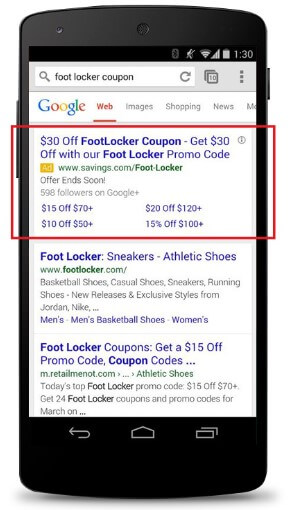Mobile SEM Strategy: How Savings.com Increased Mobile Search Revenue By 1000 Percent YoY
When Google announced Enhanced Campaigns last year, like many marketers, the team at coupon deals site Savings.com was skeptical and surprised that they would be forced to adjust their approach to mobile. In a soon-to-be-released case study from Google, Savings.com shares how they quickly pivoted to embrace a mobile-first approach that has since trickled down […]
 When Google announced Enhanced Campaigns last year, like many marketers, the team at coupon deals site Savings.com was skeptical and surprised that they would be forced to adjust their approach to mobile.
When Google announced Enhanced Campaigns last year, like many marketers, the team at coupon deals site Savings.com was skeptical and surprised that they would be forced to adjust their approach to mobile.
In a soon-to-be-released case study from Google, Savings.com shares how they quickly pivoted to embrace a mobile-first approach that has since trickled down from marketing to all areas of the business including product development.
I spoke with Savings.com head of marketing Seth Barnes about the move to a mobile-first strategy. Barnes said they had been focusing on improving the user experience on mobile by implementing responsive design across the site and launched an app prior to the holiday season last year. Mobile traffic grew quickly.
“As mobile traffic surged, we were able to gather and analyze large amounts of data that helped us evolve our strategy to really understand the different needs of mobile shoppers,” said Barnes.
With 35 to 40 percent of searches for coupons and deals come are done on smartphones, the company knew mobile was important, but as they dug into the data, they could see broader trends of changing consumer habits on smartphones. The data showed that consumers are now more comfortable with mobile purchases, and we need to keep pace with our consumers, says Barnes.
As an analytics-driven company, the challenge came in taking the new mobile search data and applying a standard of analytics that would help them monetize mobile search and increase sales as mobile traffic continues to grow.
Savings.com looked at how and when mobile users were searching and buying. The group has to consider the mobile user sitting at home and shopping online as well as the in-store shopper looking for a coupon to redeem at the checkout counter. They quickly began to see that many more transactions were actually being completed on smartphones than they had anticipated.
We also found there are certain times of day that shoppers search and buy online via mobile. We optimized our marketing strategy by dayparts based on propensity to buy, and adjusted bid modifiers to capitalize on retailers that had the highest response rates. As a result, we’ve kept our CPCs relatively low while increasing sales for our partners exponentially, says Barnes.
Proprietary search engine marketing software allows Savings.com to tie actual deal redemption data to the Google API and automate the process of displaying the best deals in real-time for each search. The software also allows them to track mobile ROI and revenue at a very granular level and measure mobile performance against desktop and tablet.
By analyzing behavioral data and optimizing ad copy, landing pages and the deals themselves for mobile experiences, Savings.com reports seeing immediate profit on a direct response basis from its mobile search campaigns. The average mobile click-through rate (CTR) is now 200 percent higher than their desktop CTR and revenue from mobile has increased 1,000 percent year-over-year.
Barnes says that mobile is now probably the most influential touch point in their whole customer journey. “Our customers aren’t clicks, they are people with a specific need. This realization is transforming our business.” All campaigns now include a mobile component.
Contributing authors are invited to create content for Search Engine Land and are chosen for their expertise and contribution to the search community. Our contributors work under the oversight of the editorial staff and contributions are checked for quality and relevance to our readers. The opinions they express are their own.
Related stories